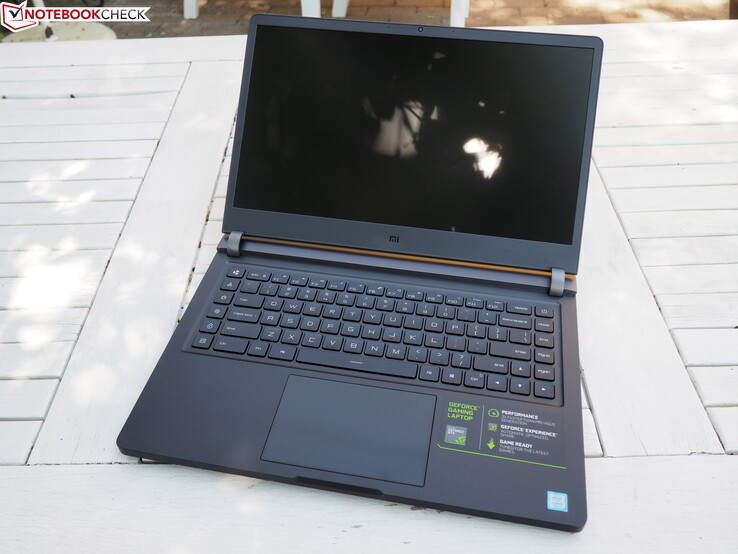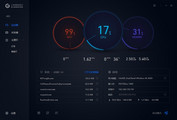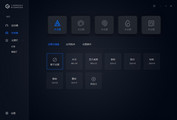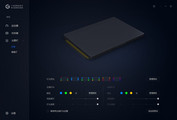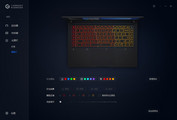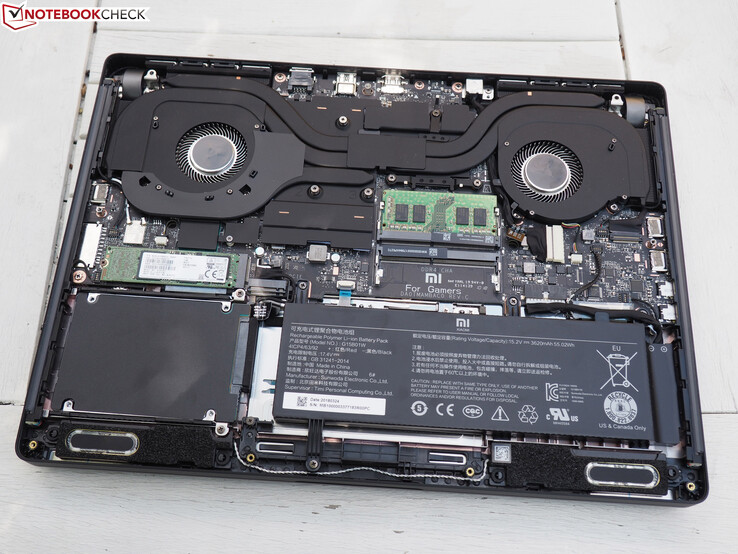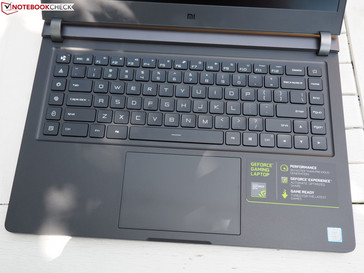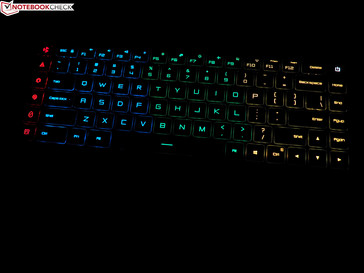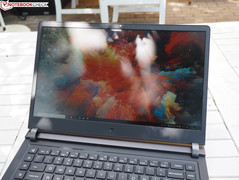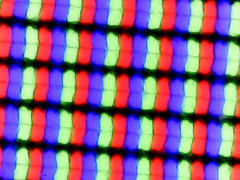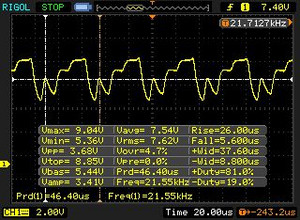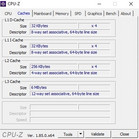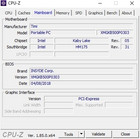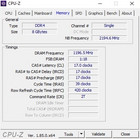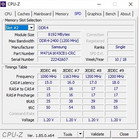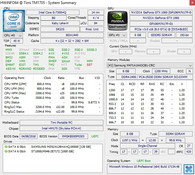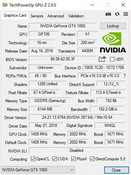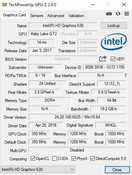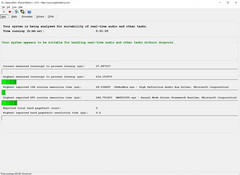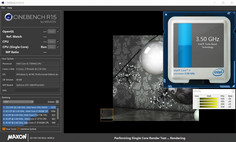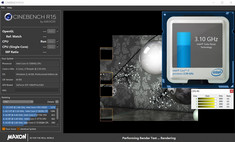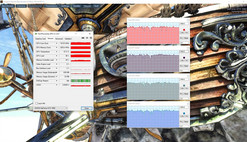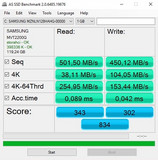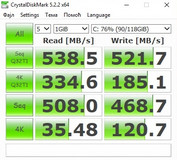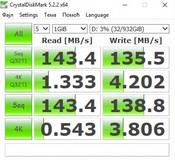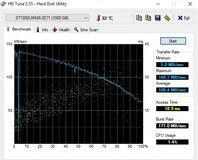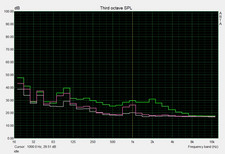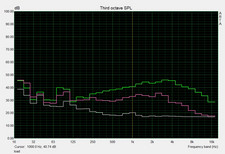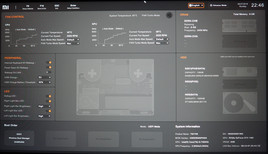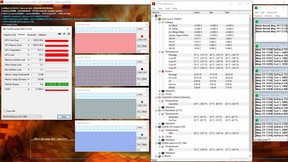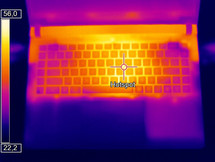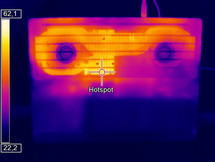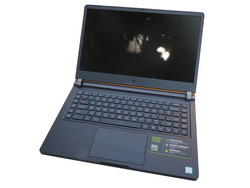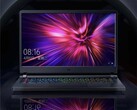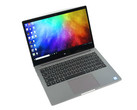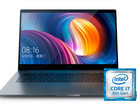Xiaomi Mi Gaming Laptop (i5-7300HQ, GTX 1060, Full HD) Review

If you take a look into our Top-10 list of the best affordable gaming notebooks, you can quickly see that mid-range GPUs on the level of the GeForce GTX 1050 (Ti) or Radeon RX 580 are dominating in the price range below 1500 Euros (~$1732). Those who only have a limited budget but want to get the maximum performance are at the right address with the Xiaomi Mi Gaming Laptop.
For the same or a similar price as the competitors, the 15-inch notebook has Nvidia's GeForce GTX 1060 high-end GPU with 6 GB of GDDR5-VRAM, bringing its images onto the IPS panel with stable viewing angles. The DirectX-12 chip is accompanied by a quad-core processor from Intel, or more exact, the Core i5-7300HQ, which although not offering Hyperthreading, is sufficient for most of the current games. In addition, our test model has 8 GB or DDR4-RAM (single-channel) and a combination of a 128-GB SSD and a 1-TB HDD.
In order to have the right device for any budget in its portfolio, Xiaomi also sells the Mi Gaming Laptop in three other configurations, which you can see listed in the table below.
| Model 1 | Model 2 | Model 3 (Test) | Model 4 | |
|---|---|---|---|---|
| Processor | Core i7-7700HQ | Core i7-7700HQ | Core i5-7300HQ | Core i5-7300HQ |
| Graphics Card | GeForce GTX 1060 | GeForce GTX 1060 | GeForce GTX 1060 | GeForce GTX 1050 Ti |
| Working Memory | 16 GB RAM | 8 GB RAM | 8 GB RAM | 8 GB RAM |
| Storage | 256 GB SSD | 128 GB SSD | 128 GB SSD | 128 GB SSD |
But those who like a good deal and see it here should be forewarned, since as a US or EU citizen, it is currently very difficult to get your hands on a unit at all. We only received the Mi Gaming Laptop through some detours. The owner of the techtablets.com website was so kind as to sell us his unit, which he originally purchased for barely 1000 Euros (~$1154) from the geekbuying.com internet shop (when importing it to Germany you would need to pay 19% value-added taxes).
Besides the availability, there is also a second problem from the western perspective. While the keyboard has the US layout, you are greeted by a Chinese version of the operating system (Windows 10 64 Bit). Granted, with a fresh license and a new installation, other languages are also possible, but the software for adjusting the keyboard illumination and the macro keys remain in Chinese, so that some functions are incomprehensible and only show their effect after trying them out. Depending on your region, you will also need to purchase the corresponding power cable.
If you disregard such smaller and larger pitfalls, the Xiaomi notebook is a serious competitor for the established manufacturers – and not just because of the fast hardware and the relatively affordable price. In our test, the Mi Gaming Laptop must prove itself against other 15-inch notebooks from the budget Top-10 list such as the HP Omen 15 and Dell Inspiron 15 7000 models with the GTX 1060 Max Q and the Acer Nitro 5 and Medion Erazer X6603 GTX 1050 Ti devices among others. Does Xiaomi really have the best package overall, or are there some hidden weaknesses?
We also tested the entry level model using a GTX 1050 Ti and the same CPU, read the full review here.
Case - Understated character
The case is definitely one of the highlights of the 15-incher. In contrast to many other gaming notebooks that often draw attention with a gimmicky and often cheap-looking design (look for example at the Acer Predator 15), the Mi Gaming Laptop appears very elegant and timeless with its modest visuals, so that you could also use the device for some more serious occasions.
In terms of its quality, the case also leaves a good to very good impression. Although the base unit is made only from plastic, with its high-quality workmanship and the convincing stability, you could think the laptop had an aluminum unibody. Only the keyboard has some give when pressing with more force in some places. The lid is made of metal and is surprisingly robust for a notebook despite the bezel being relatively slim.
However, the 15-inch gamer still misses the mobility of an MSI GS65 Stealth Thin or a Gigabyte Aero 15X. A weight of 2.7 kg (~5.9 lb) is not optimal for frequent transport, even though the Mi Gaming Laptop follows the competition here. All the devices we are using in our test weigh between 2.6 and 2.7 kg (~5.7 - 5.9 lb). In terms of its thickness, the Xiaomi stands out positively, though. At 23 mm (~0.9 in), the "underdog" is a tick slimmer than its competitors, which reach 25 to 29 mm (~1 - 1.1 in, not counting the case feet).
It also receives some plus points for the hinges with an unusual design, which are able to hold the display tightly in place even when there is some shaking. The bottom of the case shows some further unique features. Not only did Xiaomi equip the bottom with a large grid, offering a view of the cooling system inside, but there are also some slim LED bars that can be illuminated in various colors and modes.
Equipment - Only second league
Connections
In terms of its equipment, we can see various cost-cutting measures. To keep the price as low as possible, the manufacturer has done some cost cutting, not the least in the connections. Thus, the buyers have to make do without a Thunderbolt-3 port, a Kensington Lock, and a dedicated DisplayPort. The latter was at least implemented via USB-C. Regarding the USB, in addition to a Type-C port, the 15-incher offers four classical Type-A ports of the 3.0 generation, which are positioned on the side and the back. The package is rounded off by an RJ45 port, an HDMI output, a card reader, and two audio ports (headphones + microphone), which are unfortunately unlabeled, just like all the other ports.
There is hardly anything to complain about concerning the positioning of the connections. Since almost all the connections are at the back half of the case, an external mouse usually has enough room to move freely.
SDCard Reader
Those who expect a fast card reader will be disappointed by the Mi Gaming Laptop. Barely 30 MB/s during sequential reads or writes and the transfer of images correspond only to USB-2.0 levels. The HP Omen 15 and the Medion Erazer X6603, which achieve around USB-3.0 speeds, show that this can be done faster. Some gaming notebooks are even able to crack the 100 or 200-MB mark, and theoretically our reference card would manage up to 260 MB/s.
| SD Card Reader | |
| average JPG Copy Test (av. of 3 runs) | |
| Average of class Gaming (20 - 210, n=65, last 2 years) | |
| HP Omen 15-ce002ng (Toshiba Exceria Pro SDXC 64 GB UHS-II) | |
| Medion Erazer X6603 (oshiba Exceria Pro SDXC 64 GB UHS-II) | |
| Xiaomi Mi Gaming Laptop 7300HQ 1060 (Toshiba Exceria Pro SDXC 64 GB UHS-II) | |
| Dell Inspiron 15 7000 7577 (Toshiba Exceria Pro SDXC 64 GB UHS-II) | |
| maximum AS SSD Seq Read Test (1GB) | |
| Average of class Gaming (25.8 - 261, n=62, last 2 years) | |
| HP Omen 15-ce002ng (Toshiba Exceria Pro SDXC 64 GB UHS-II) | |
| Medion Erazer X6603 (oshiba Exceria Pro SDXC 64 GB UHS-II) | |
| Dell Inspiron 15 7000 7577 (Toshiba Exceria Pro SDXC 64 GB UHS-II) | |
| Xiaomi Mi Gaming Laptop 7300HQ 1060 (Toshiba Exceria Pro SDXC 64 GB UHS-II) | |
Communication
The 15-incher is also unable to play at the top in terms of the wireless communication. Although 659 Mbit/s during the receive test is sufficient for second place, an average of 363 Mbit/s during the send test (both in 1 meter (~3.3 ft) distance from the Linksys EA8500 reference router) are only mediocre and result in last place. Looking at the Dell Inspiron 15 7000 and the Medion Erazer X6603, you can see that the built-in Intel Wireless AC-8265 Wi-Fi chip can really perform better.
Software
As mentioned in the beginning, the preinstalled software is in Chinese. The central control app is the Mi Gaming Box. Not only can you find system information (such as CPU, GPU, and RAM usage) in its menus, but also configuration options for the Macro keys and the illumination settings of the case (keyboard, bars on the sides). As far as we could figure out, there is no option for fan control or overclocking.
Accessories
In terms of accessories, the buyers will only receive a Quick Start Guide and a power supply. While the 180-watt model is not particularly heavy at about 0.5 kg (~1.1 lb), it takes a lot of space during transport (about 16 x 7.5 x 2.5 cm, ~6.3 x 3 x 1 in).
Maintenance
The maintenance is reminiscent of other gaming notebooks. After you have removed nine Philips screws from the back (attention: one is hidden under the center of the rubber cover of the longish foot), the bottom of the case can be removed, which due to the additional hooks is harder than it looks and requires a tool to pry it off.
As soon as you have successfully performed this procedure, all the inside components can be accessed. Xiaomi has provided the Mi Gaming Laptop with two fans and several heat pipes, two RAM banks, two M.2 slots, and one 2.5-inch slot. The last is clearly at the expense of the battery capacity, so the author would have rather left this out, in particular since one of the two M.2 slots can apparently only be used if you take out the 2.5-inch drive – very awkward.
Input Devices - Top level
Keyboard
In the input devices, Xiaomi does almost everything right. Although it takes a little getting used to the layout with the Macro keys positioned on the left side (in the beginning we often hit the wrong key in the main block), otherwise we have nothing to complain about the keyboard. Despite the chiclet design, the rounded keys are comfortably large at 16 x 16 mm (~0.6 x 0.6 in). The typing experience reminded us of mechanical keyboards and we liked it. Compared to some of the other gaming laptops, the pressure point and stroke are fairly defined and crisp (even though the keyboard could have been a little more solid, as mentioned above).
Gamers should be pleased with the intensive RGB illumination, which can be adjusted in several steps, has various modes, and can be split into four zones, if so desired. It is great that due to their bright labels, the keys can be easily seen even without illumination. On the other hand, you could argue about the absence of a number block.
Touchpad
The mouse substitute follows the current ClickPad trend that does without the dedicated keys. Since Xiaomi has placed the keyboard far back, leading to a pleasingly large palm rest, the touchpad also has a lot of space. At a size of about 12 x 8 cm (~4.7 x 3.1 in), the smooth surface is amply sized so that you can draw longer lines without having to reset the finger.
As necessary for a modern device, the Mi Gaming Laptop also supports various gestures. Zooming and scrolling via 2-finger touch worked without a hitch in the test. The ClickPad also recognizes left and right clicks reliably most of the time, although conventional touchpads are slightly ahead in this area. In contrast to the keyboard which can be operated fairly quietly and is thus suited for quieter surroundings, the mouse substitute was clacking noticeably during input.
Display - Light and shade
The Full HD display offered a mixed performance. From a gamer point of view, we would call the panel less than optimal. In addition to the lack of the G-Sync support, which is due to the Optimus graphics switching, some buyers will also miss a high frequency choice. In times of 120 and 144 Hz panels, 60 Hz are not up-to-date anymore.
| |||||||||||||||||||||||||
Brightness Distribution: 87 %
Center on Battery: 250 cd/m²
Contrast: 1230:1 (Black: 0.23 cd/m²)
ΔE ColorChecker Calman: 4.68 | ∀{0.5-29.43 Ø4.78}
calibrated: 2.5
ΔE Greyscale Calman: 4.32 | ∀{0.09-98 Ø5}
87% sRGB (Argyll 1.6.3 3D)
57% AdobeRGB 1998 (Argyll 1.6.3 3D)
63.8% AdobeRGB 1998 (Argyll 3D)
87.3% sRGB (Argyll 3D)
66.6% Display P3 (Argyll 3D)
Gamma: 2.36
CCT: 7612 K
| Xiaomi Mi Gaming Laptop 7300HQ 1060 BOEhydis NV156FHM-N61 (BOE0747), IPS, 1920x1080 | Dell Inspiron 15 7000 7577 ID: LG Philips LGD053F, Name: 156WF6, Dell P/N: 4XK13, IPS, 1920x1080 | HP Omen 15-ce002ng AUO42ED, IPS, 1920x1080 | Acer Nitro 5 AN515-51-788E LG Philips LP156WF6-SPK6, IPS, 1920x1080 | Medion Erazer X6603 LP156WF6-SPK3, AH-IPS, LED, 1920x1080 | |
|---|---|---|---|---|---|
| Display | -40% | 2% | -33% | -41% | |
| Display P3 Coverage (%) | 66.6 | 37.07 -44% | 65.8 -1% | 41.7 -37% | 36.82 -45% |
| sRGB Coverage (%) | 87.3 | 55.6 -36% | 90.9 4% | 62.2 -29% | 54.9 -37% |
| AdobeRGB 1998 Coverage (%) | 63.8 | 38.32 -40% | 66.5 4% | 43.17 -32% | 38.09 -40% |
| Response Times | 34% | 22% | 41% | 22% | |
| Response Time Grey 50% / Grey 80% * (ms) | 53.2 ? | 35.6 ? 33% | 43.2 ? 19% | 35 ? 34% | 46 ? 14% |
| Response Time Black / White * (ms) | 41.6 ? | 27.6 ? 34% | 31.2 ? 25% | 22 ? 47% | 29 ? 30% |
| PWM Frequency (Hz) | 21550 ? | 2174 ? | |||
| Screen | -31% | 8% | -16% | -33% | |
| Brightness middle (cd/m²) | 283 | 235.4 -17% | 304 7% | 276 -2% | 252 -11% |
| Brightness (cd/m²) | 269 | 223 -17% | 289 7% | 265 -1% | 246 -9% |
| Brightness Distribution (%) | 87 | 91 5% | 86 -1% | 91 5% | 94 8% |
| Black Level * (cd/m²) | 0.23 | 0.28 -22% | 0.26 -13% | 0.25 -9% | 0.23 -0% |
| Contrast (:1) | 1230 | 841 -32% | 1169 -5% | 1104 -10% | 1096 -11% |
| Colorchecker dE 2000 * | 4.68 | 5.6 -20% | 3.46 26% | 5.06 -8% | 7.83 -67% |
| Colorchecker dE 2000 max. * | 8 | 20.3 -154% | 7.72 3% | 10.13 -27% | 15.5 -94% |
| Colorchecker dE 2000 calibrated * | 2.5 | ||||
| Greyscale dE 2000 * | 4.32 | 3.6 17% | 2.46 43% | 6.25 -45% | 7.11 -65% |
| Gamma | 2.36 93% | 2.23 99% | 2.38 92% | 1.76 125% | 2.19 100% |
| CCT | 7612 85% | 7214 90% | 6915 94% | 6873 95% | 7930 82% |
| Color Space (Percent of AdobeRGB 1998) (%) | 57 | 35.2 -38% | 59 4% | 40 -30% | 35 -39% |
| Color Space (Percent of sRGB) (%) | 87 | 55.4 -36% | 91 5% | 62 -29% | 55 -37% |
| Total Average (Program / Settings) | -12% /
-24% | 11% /
8% | -3% /
-12% | -17% /
-27% |
* ... smaller is better
Added to this is the meager response time. 41.6 ms when changing from black to white and 53.2 ms changing from gray to gray result in the last place in the test field. For comparison, the IPS panels of the Dell Inspiron 15 7000 and the Acer Nitro 5 remain below 30 and 40 ms respectively here. At least, we did not notice any prominent streaking.
If we concentrate on the remaining display values of the built in panel with the type designation BOEhydis NV156FHM-N61, we can also see some strengths. Although at an average brightness of 269 cd/m², the 15-inch screen is not one of the brightest (leading to some problems outdoors), thanks to its low black value (0.23 cd/m²), there is a high contrast of 1230:1, so that games, movies, and images appear very vivid and differentiated. For a gaming notebook, the color space is also decent. 87% sRGB and 57% are only bested by the HP Omen 15 in our competition.
Xiaomi could improve a little on the color accuracy. In the state of delivery, the panel has a slight blue tint, although this can be improved by some calibration (or you could just install our ICC file). Our test unit hardly had to struggle with screen bleeding or annoying halos. There was only a small lighter area in the left top corner. However, this only became noticeable in completely dark images.
Display Response Times
| ↔ Response Time Black to White | ||
|---|---|---|
| 41.6 ms ... rise ↗ and fall ↘ combined | ↗ 23.6 ms rise | |
| ↘ 18 ms fall | ||
| The screen shows slow response rates in our tests and will be unsatisfactory for gamers. In comparison, all tested devices range from 0.1 (minimum) to 240 (maximum) ms. » 98 % of all devices are better. This means that the measured response time is worse than the average of all tested devices (20.2 ms). | ||
| ↔ Response Time 50% Grey to 80% Grey | ||
| 53.2 ms ... rise ↗ and fall ↘ combined | ↗ 26.4 ms rise | |
| ↘ 26.8 ms fall | ||
| The screen shows slow response rates in our tests and will be unsatisfactory for gamers. In comparison, all tested devices range from 0.165 (minimum) to 636 (maximum) ms. » 90 % of all devices are better. This means that the measured response time is worse than the average of all tested devices (31.6 ms). | ||
Screen Flickering / PWM (Pulse-Width Modulation)
| Screen flickering / PWM detected | 21550 Hz | ≤ 99 % brightness setting | |
The display backlight flickers at 21550 Hz (worst case, e.g., utilizing PWM) Flickering detected at a brightness setting of 99 % and below. There should be no flickering or PWM above this brightness setting. The frequency of 21550 Hz is quite high, so most users sensitive to PWM should not notice any flickering. In comparison: 53 % of all tested devices do not use PWM to dim the display. If PWM was detected, an average of 8118 (minimum: 5 - maximum: 343500) Hz was measured. | |||
Performance - Competitive
Although the Mi Gaming Laptop in our test configuration has to be content with 8 GB of RAM (here we recommend an upgrade to 16 GB) and does not contain a Coffee Lake chip with six cores yet, we can still classify the 15-incher as a high-end notebook.
Processor
Besides the graphics card, the processor is also different between the models. While there is a Core i7-7700HQ with a 2.8-3.8 GHz clock speed and Hyperthreading technology (8 parallel threads) in the more expensive models, in the more affordable versions, there is only the Core i5-7300HQ, which has a clock speed of 2.5-3.5 GHz, does not support Hyperthreading, and can thus only run four threads simultaneously.
This situation is also reflected in the performance. During the multi-core test of Cinebench R15, the Mi Gaming Laptop is surpassed by about 40% by the competitors with the Core i7-7700HQ. We will evaluate next, whether the weaker CPU also has a negative effect during 3D applications.
The clock speed behavior of the Core i5-7300HQ gives no reason for complaint. In our Cinebench loop, which runs for at least 30 minutes, the 15-incher presents a very constant performance. 3.1 GHz are identical to Intel's specifications for the multi-core Turbo.
System Performance
If you believe PCMark 10, the cost-cutting measures in the CPU, RAM, and SSD lower the available system speed by quite a bit. Despite having the most powerful GPU in our test field, the Mi Gaming Laptop is bested by the competitors by 5 to 16%. However, most of the time you will not notice a difference in everyday operations. All the devices boot up comfortably quick and respond very fast otherwise.
| PCMark 8 Home Score Accelerated v2 | 3910 points | |
| PCMark 8 Work Score Accelerated v2 | 4912 points | |
| PCMark 10 Score | 4197 points | |
Help | ||
Storage Solution
Since Windows 10 already eats up dozens of GB and more and more of the current games need more than 50 GB, the buyer often has no choice but storing his gaming collection on the secondary (and much slower) storage. The built-in 1-TB HDD from Seagate runs at 5400 rpm and achieves a typical performance level.
| Xiaomi Mi Gaming Laptop 7300HQ 1060 Samsung PM871b MZNLN128HAHQ | Dell Inspiron 15 7000 7577 Samsung PM961 MZVLW256HEHP | HP Omen 15-ce002ng Samsung PM961 MZVLW256HEHP | Acer Nitro 5 AN515-51-788E Intel SSD 600p SSDPEKKW256G7 | Medion Erazer X6603 Samsung PM961 MZVLW256HEHP | |
|---|---|---|---|---|---|
| AS SSD | 165% | 29% | 175% | ||
| Seq Read (MB/s) | 502 | 2652 428% | 1404 180% | 2805 459% | |
| Seq Write (MB/s) | 450.1 | 1181 162% | 521 16% | 1081 140% | |
| 4K Read (MB/s) | 38.11 | 46.95 23% | 27.86 -27% | 46.58 22% | |
| 4K Write (MB/s) | 104.1 | 100.2 -4% | 75 -28% | 129.3 24% | |
| Score Read (Points) | 343 | 1241 262% | 446 30% | 1162 239% | |
| Score Write (Points) | 302 | 594 97% | 344 14% | 750 148% | |
| Score Total (Points) | 834 | 2405 188% | 984 18% | 2431 191% |
Graphics Card
Due to the massive performance jump, gamers should directly go for the GTX 1060 model, since with a GTX 1050 Ti, the Mi Gaming Laptop would be noticeably slower, as the Medion Erazer X6603 and the Acer Nitro 5 also confirm.
The latter notebooks are surpassed by more than 50% in the Fire-Strike test of 3DMark 13. The distance to the GeForce GTX 1060 Max Q of the HP Omen 15 and Dell Inspiron 15 7000 is almost 15%.
| 3DMark 11 Performance | 11106 points | |
| 3DMark Cloud Gate Standard Score | 16619 points | |
| 3DMark Fire Strike Score | 9249 points | |
Help | ||
Using the RPG hit The Witcher 3, we test whether the good 3D performance can also be maintained over a longer period. The result: even after 60 minutes, the frame rate hardly drops, from which we gather that the Turbo of the graphics card remains constant. The GeForce GTX 1060 is able to overclock via GPU Boost from the standard 1405 up to 1900 MHz, with the value leveling out at a good 1670 MHz in The Witcher 3.
Gaming Performance
The combination of 8 GB of single-channel RAM and a quad-core CPU without Hyperthreading fails to power every game perfectly.
| The Witcher 3 - 1920x1080 Ultra Graphics & Postprocessing (HBAO+) | |
| Average of class Gaming (18.4 - 240, n=55, last 2 years) | |
| Xiaomi Mi Gaming Laptop 7300HQ 1060 | |
| Dell Inspiron 15 7000 7577 | |
| HP Omen 15-ce002ng | |
| Acer Nitro 5 AN515-51-788E | |
While The Witcher 3, Fortnite, Elex and the benchmark of Final Fantasy 15 are displayed in maximum detail (1920x1080) as fast as on the other GTX 1060 laptops, the performance in Far Cry 5, The Evil Within 2, and Kingdom Come Deliverance turned out noticeably lower in some parts. However, the latter games never slid into an "unplayable" range.
| low | med. | high | ultra | |
|---|---|---|---|---|
| The Witcher 3 (2015) | 72.8 | 40.3 | ||
| The Evil Within 2 (2017) | 36.5 | 35.1 | ||
| ELEX (2017) | 70.9 | 54 | ||
| Fortnite (2018) | 91.5 | 81.4 | ||
| Final Fantasy XV Benchmark (2018) | 39.8 | |||
| Kingdom Come: Deliverance (2018) | 43.6 | 36 | ||
| Far Cry 5 (2018) | 62 | 59 |
Emissions - Screamer
Noise Emissions
The worst weakness of the Mi Gaming laptop is its high noise development. While the 15-inch notebook did not become too loud in the 3DMark 06 at 38-44 dB(A), after 60 minutes of The Witcher 3, the fans were screaming at 50 dB(A) on average, which corresponds to a clearly noticeable and, for many users, annoying noise level. At full speed, we measured even up to 55 dB(A). The comparison field behaved much quieter in 3D operation.
The high fan speed of the Mi Gaming Laptops can hardly be explained by high hardware temperatures. For example during the Witcher 3 run, the Core i5-7300HQ only warmed up to about 60 °C (140 °F). About 68 °C (154 °F) for the GeForce GTX 1060 are also moderate, so Xiaomi should be able to adjust the fan speed curve more gently. (Note: The BIOS offers an option to reduce the maximum speed.)
The notebook also deserves some complaint in idle mode as well. Although the fans turn off completely in the ideal case, so that you can only hear a slight HDD noise, from time to time the cooling system revs up unnecessarily. During supposedly small and harmless tasks such as Windows updates, installations, and program starts, the fans really like to turn on and come close to 40 dB(A). The competitors do this better most of the time.
Noise level
| Idle |
| 30 / 34 / 38 dB(A) |
| HDD |
| 32 dB(A) |
| Load |
| 44 / 55 dB(A) |
 | ||
30 dB silent 40 dB(A) audible 50 dB(A) loud |
||
min: | ||
| Xiaomi Mi Gaming Laptop 7300HQ 1060 GeForce GTX 1060 Mobile, i5-7300HQ | Dell Inspiron 15 7000 7577 GeForce GTX 1060 Max-Q, i5-7300HQ | HP Omen 15-ce002ng GeForce GTX 1060 Max-Q, i7-7700HQ | Acer Nitro 5 AN515-51-788E GeForce GTX 1050 Ti Mobile, i7-7700HQ | Medion Erazer X6603 GeForce GTX 1050 Ti Mobile, i7-7700HQ | Average of class Gaming | |
|---|---|---|---|---|---|---|
| Noise | 18% | 5% | 9% | 10% | 13% | |
| off / environment * (dB) | 30 | 28 7% | 30 -0% | 30.6 -2% | 30.9 -3% | 24.1 ? 20% |
| Idle Minimum * (dB) | 30 | 28 7% | 30 -0% | 30.6 -2% | 30.9 -3% | 26.1 ? 13% |
| Idle Average * (dB) | 34 | 28 18% | 33 3% | 30.7 10% | 30.9 9% | 27.7 ? 19% |
| Idle Maximum * (dB) | 38 | 28 26% | 37 3% | 30.7 19% | 31.6 17% | 30.1 ? 21% |
| Load Average * (dB) | 44 | 30.3 31% | 41 7% | 43 2% | 38.5 12% | 43 ? 2% |
| Witcher 3 ultra * (dB) | 50 | 39.5 21% | 42 16% | 39.7 21% | ||
| Load Maximum * (dB) | 55 | 46.5 15% | 50 9% | 45.8 17% | 40.8 26% | 53.8 ? 2% |
* ... smaller is better
Temperature
As we already indicated, the temperatures are all right. During the stress test with the FurMark and Prime95 tools, we were only able to measure up to 73 °C (163 °F) at the GeForce GTX 1060. The reason for the passable value is that the GPU throttles down to 1260 MHz (only during FurMark). Under full load, the CPU ran with the Turbo activated. After the Nvidia chip began throttling, the temperature of the Core i5-7300HQ dropped from 90 (194 °F) to about 70-80 °C (158-176 °F).
The case also does not warm up too much. During the 60-minute test with The Witcher 3, the top only heated up to a maximum of 44 °C (111 °F; during the stress test: 46 °C, 115 °F). Since the palm rest always remains below 30 °C (86°F), longer gaming sessions should not pose a problem. It can only become uncomfortable on the lap, since the bottom of the case reaches up to 52 °C (126 °F).
(-) The maximum temperature on the upper side is 46 °C / 115 F, compared to the average of 40.4 °C / 105 F, ranging from 21.2 to 68.8 °C for the class Gaming.
(-) The bottom heats up to a maximum of 52 °C / 126 F, compared to the average of 43.3 °C / 110 F
(+) In idle usage, the average temperature for the upper side is 27.2 °C / 81 F, compared to the device average of 33.9 °C / 93 F.
(±) Playing The Witcher 3, the average temperature for the upper side is 37.1 °C / 99 F, compared to the device average of 33.9 °C / 93 F.
(+) The palmrests and touchpad are cooler than skin temperature with a maximum of 28 °C / 82.4 F and are therefore cool to the touch.
(±) The average temperature of the palmrest area of similar devices was 28.9 °C / 84 F (+0.9 °C / 1.6 F).
| Xiaomi Mi Gaming Laptop 7300HQ 1060 GeForce GTX 1060 Mobile, i5-7300HQ | Dell Inspiron 15 7000 7577 GeForce GTX 1060 Max-Q, i5-7300HQ | HP Omen 15-ce002ng GeForce GTX 1060 Max-Q, i7-7700HQ | Acer Nitro 5 AN515-51-788E GeForce GTX 1050 Ti Mobile, i7-7700HQ | Medion Erazer X6603 GeForce GTX 1050 Ti Mobile, i7-7700HQ | Average of class Gaming | |
|---|---|---|---|---|---|---|
| Heat | 13% | -11% | 16% | 18% | 1% | |
| Maximum Upper Side * (°C) | 46 | 44 4% | 47 -2% | 41.1 11% | 44.3 4% | 45.6 ? 1% |
| Maximum Bottom * (°C) | 52 | 43.8 16% | 54 -4% | 38.8 25% | 39.5 24% | 48.3 ? 7% |
| Idle Upper Side * (°C) | 32 | 26 19% | 36 -13% | 28.7 10% | 24.8 22% | 31.4 ? 2% |
| Idle Bottom * (°C) | 32 | 28 12% | 40 -25% | 26.9 16% | 24.6 23% | 34.4 ? -8% |
* ... smaller is better
Speakers
Despite the "budget price," the sound does not need to hide behind the competitors. The opposite is the case. Xiaomi is using a 2.0 system which is positioned at the case front, certified for Dolby Atmos, and offers a better sound than the Dell Inspiron 15 7000 according to our audio analysis. Another positive: Thanks to the high maximum volume of 88 dB(A), the 15-incher is not only suited for small rooms or sitting close by but even larger spaces.
Although movies, music, and games are shown to good effect, when using a headset or external speakers you usually get better sound quality.
Xiaomi Mi Gaming Laptop 7300HQ 1060 audio analysis
(+) | speakers can play relatively loud (88 dB)
Bass 100 - 315 Hz
(±) | reduced bass - on average 13.5% lower than median
(±) | linearity of bass is average (8.5% delta to prev. frequency)
Mids 400 - 2000 Hz
(+) | balanced mids - only 4.6% away from median
(+) | mids are linear (5% delta to prev. frequency)
Highs 2 - 16 kHz
(+) | balanced highs - only 2.6% away from median
(+) | highs are linear (4.4% delta to prev. frequency)
Overall 100 - 16.000 Hz
(+) | overall sound is linear (13.2% difference to median)
Compared to same class
» 18% of all tested devices in this class were better, 4% similar, 77% worse
» The best had a delta of 6%, average was 18%, worst was 132%
Compared to all devices tested
» 13% of all tested devices were better, 3% similar, 85% worse
» The best had a delta of 4%, average was 24%, worst was 134%
Dell Inspiron 15 7000 7577 audio analysis
(±) | speaker loudness is average but good (80.9 dB)
Bass 100 - 315 Hz
(±) | reduced bass - on average 13% lower than median
(+) | bass is linear (6.8% delta to prev. frequency)
Mids 400 - 2000 Hz
(+) | balanced mids - only 2.7% away from median
(+) | mids are linear (5.3% delta to prev. frequency)
Highs 2 - 16 kHz
(±) | higher highs - on average 8% higher than median
(±) | linearity of highs is average (10.6% delta to prev. frequency)
Overall 100 - 16.000 Hz
(±) | linearity of overall sound is average (18.9% difference to median)
Compared to same class
» 62% of all tested devices in this class were better, 8% similar, 30% worse
» The best had a delta of 6%, average was 18%, worst was 132%
Compared to all devices tested
» 43% of all tested devices were better, 8% similar, 49% worse
» The best had a delta of 4%, average was 24%, worst was 134%
Power Management - Unspectacular
Power Consumption
Without G-Sync, the path is free for Nvidia's Optimus graphics switching. This massively lowers the power consumption during idle operation, since then only the graphics chip of the processor is used (HD Graphics 630). 10-19 watts are about in the middle between the GTX 1060 Max Q notebooks Dell Inspiron 15 7000 (7-9 watts) and HP Omen 15 (18-30 watts). The GTX 1050 Ti laptops from Acer (4-10 watts) and Medion (5-9 watts) operate even more efficiently, which does not always have an effect on the battery life, though.
Under load, the Mi Gaming Laptop draws between 68 and 136 watts of power. Considering the graphics power, this is relatively little, and it can be mainly traced back to the Core i5-7300HQ which is more efficient than the Core i7-7700HQ in 3D operation.
| Off / Standby | |
| Idle | |
| Load |
|
Key:
min: | |
| Xiaomi Mi Gaming Laptop 7300HQ 1060 GeForce GTX 1060 Mobile, i5-7300HQ | Dell Inspiron 15 7000 7577 GeForce GTX 1060 Max-Q, i5-7300HQ | HP Omen 15-ce002ng GeForce GTX 1060 Max-Q, i7-7700HQ | Acer Nitro 5 AN515-51-788E GeForce GTX 1050 Ti Mobile, i7-7700HQ | Medion Erazer X6603 GeForce GTX 1050 Ti Mobile, i7-7700HQ | Average of class Gaming | |
|---|---|---|---|---|---|---|
| Power Consumption | 29% | -41% | 24% | 29% | -57% | |
| Idle Minimum * (Watt) | 10 | 7.1 29% | 18 -80% | 4.1 59% | 4.7 53% | 13.7 ? -37% |
| Idle Average * (Watt) | 13 | 7.6 42% | 23 -77% | 6.9 47% | 7.6 42% | 19.6 ? -51% |
| Idle Maximum * (Watt) | 19 | 8.6 55% | 30 -58% | 9.5 50% | 9.2 52% | 26.3 ? -38% |
| Load Average * (Watt) | 68 | 59.5 12% | 85 -25% | 83 -22% | 81 -19% | 111.2 ? -64% |
| Witcher 3 ultra * (Watt) | 110 | 89 19% | 96 13% | 108 2% | ||
| Load Maximum * (Watt) | 136 | 112.8 17% | 158 -16% | 126 7% | 112 18% | 263 ? -93% |
* ... smaller is better
Battery Life
The battery life of the Mi Gaming Laptop leaves it in the middle of the field. Barely 4.5 hours of Internet surfing via WLAN or playing of HD videos (brightness adjusted to about 150 cd/m²) are neither bad nor particularly good. The same goes for the maximum of 6.5 hours in idle mode. While the Medion Erazer X6603 and the HP Omen 15 have no chance in the direct comparison, the Dell Inspiron 15 7000 and the Acer Nitro 5 last considerably longer at a maximum of 11 and 15 hours respectively – and that despite the battery having a similar capacity.
In general, the Xiaomi does not have the best battery capacity. 55 Wh are only mediocre. Other slim gaming notebooks such as the Gigabyte Aero 15X put more value on mobility and boast with batteries in the 80 or 90-Wh range.
| Xiaomi Mi Gaming Laptop 7300HQ 1060 GeForce GTX 1060 Mobile, i5-7300HQ, 55 Wh | Dell Inspiron 15 7000 7577 GeForce GTX 1060 Max-Q, i5-7300HQ, 56 Wh | HP Omen 15-ce002ng GeForce GTX 1060 Max-Q, i7-7700HQ, 70 Wh | Acer Nitro 5 AN515-51-788E GeForce GTX 1050 Ti Mobile, i7-7700HQ, 48 Wh | Medion Erazer X6603 GeForce GTX 1050 Ti Mobile, i7-7700HQ, 45 Wh | Average of class Gaming | |
|---|---|---|---|---|---|---|
| Battery runtime | 48% | -19% | 46% | -18% | 49% | |
| Reader / Idle (h) | 6.4 | 11 72% | 4.3 -33% | 14.9 133% | 5.7 -11% | 9.99 ? 56% |
| H.264 (h) | 4.4 | 3.7 -16% | 5.2 18% | 3.8 -14% | 8.1 ? 84% | |
| WiFi v1.3 (h) | 4.6 | 6.9 50% | 3.3 -28% | 6.7 46% | 4.3 -7% | 6.71 ? 46% |
| Load (h) | 1.3 | 1.6 23% | 1.3 0% | 1.1 -15% | 0.8 -38% | 1.435 ? 10% |
Verdict - The price-performance tip
Pros
Cons
Cheap goods from the Far East? While this prejudice might fit many products, it does not suit the Mi Gaming Laptop. In most of the categories, the 15-inch laptop can keep up easily with the competition or even surpasses it.
Although the case is no lightweight and there are even slimmer high-end notebooks, we were quite enthusiastic about the case. The workmanship, quality of materials, and design are beyond reproach. The input devices and the sound also feel better than in some 2000 or 3000-Euro (~$2309-3464) notebook.
But of course, not everything that shines is really gold. In order to keep the price attractive, Xiaomi was forced to cut some corners in some details, such as the lame card reader, the slow Wi-Fi performance, or the lack of certain connections (Thunderbolt 3, Kensington Lock). While 8 GB RAM and a 128-GB SSD are also meager, you can also purchase the device in a configuration with 16 GB and a 256-GB SSD.
But we could get over all these points in our opinion. What are clearly more annoying are the high noise level in 3D operation and the pointless fan behavior in idle mode. Although these are typical phenomena in gaming laptops, the competitors often allow alleviating them via manual adjustment. Whether you consider the lack of G-Sync technology a negative point is a matter of taste. Xiaomi implements Optimus instead, which helps the battery life.
The display leaves some mixed feelings. On one hand, we like the high contrast and the stable viewing angles, but on the other hand, some of the current gamer criteria (120/144 Hz, short response time) remain unfulfilled. Before the purchase, you should also know that due to the Chinese software, the Mi Gaming Laptop is meant only to a limited extent for the EU or US market. However, those who are not daunted by the entry obstacles and have the fortune to receive a unit directly or through some detours will get a successful overall package at a bargain price.
At the end of the day, the underdog advances to an insider tip and grabs a high placement in our list of the 10 best budget gaming notebooks.
Xiaomi Mi Gaming Laptop 7300HQ 1060
- 05/28/2018 v6 (old)
Florian Glaser




